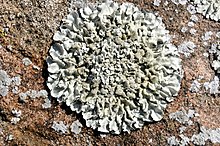| Xanthoparmelia mexicana | |
|---|---|

| |
| Scientific classification | |
| Domain: | Eukaryota |
| Kingdom: | Fungi |
| Division: | Ascomycota |
| Class: | Lecanoromycetes |
| Order: | Lecanorales |
| Family: | Parmeliaceae |
| Genus: | Xanthoparmelia |
| Species: | X. mexicana |
| Binomial name | |
| Xanthoparmelia mexicana (Gyeln.) Hale (1974) | |
| Synonyms | |
| |
Xanthoparmelia mexicana, commonly known as the salted rock-shield, is a foliose lichen in the family Parmeliaceae. It grows in 4–10 cm diameter rosettes of gray-green to yellow-green lobes in arid climates all over the world.
Taxonomy
It was originally described in 1931 as a species of Parmelia by Hungarian lichenologist Vilmos Kőfaragó-Gyelnik. It was one of 93 species that was transferred to Xanthoparmelia when Mason Hale promoted that taxon from subgeneric to generic status in 1974. It is commonly known as the salted rock-shield.
Description
Xanthoparmelia mexicana grows in 4–10 centimetres (1.6–3.9 in) diameter rosettes consisting of small lobes. The lower surface is pale to medium brown. Apothecia are uncommon; when present, they are cinnamon to dark-brown colored discs with smooth margins, and no pruina. Lichen spot tests are negative for the upper cortex (K−, C−, KC−, P−). For the medulla they are K+ yellow to dark red, C−, KC−, and P+ orange. It produces secondary metabolites including usnic acid and salazinic acid.
Habitat and distribution
Xanthoparmelia mexicana grows in open and arid climates all over the world. It may loosely cling to the substrate (adnate). In the Sonoran Desert, it may be the most commonly found member of its genus. The lichen has been recorded from western North America, Mexico, the Dominican Republic, South America, Africa, Asia, Australia, and New Zealand.
See also
References
- "Synonymy: Xanthoparmelia mexicana (Gyeln.)". Species Fungorum. Retrieved Jun 7, 2020.
- ^ Brodo, Irwin M.; Sharnoff, Sylvia Duran; Sharnoff, Stephen (2001). Lichens of North America. Yale University Press. p. 738. ISBN 978-0300082494.
- Kőfaragó-Gyelnik, V. (1931). "Additamenta ad cognitionem Parmelianum II". Fedde Repertorium Specierum Novarum Regni Vegetatilis (in Latin). 29: 273–291.
- Hale, Mason E. (1974). "Bulbothrix, Parmelina, Relicina, Xanthoparmelia, four new genera in the Parmeliaceae (Lichenes)". Phytologia. 28 (5): 479–490.
- ^ Lichen Flora of the Greater Sonoran Desert Region. Vol 2., Nash, T.H., Ryan, B.D., Gries, C., Bugartz, F., (eds.), 2001,
- Hale, Mason (1990). A Synopsis of the Lichen Genus Xanthoparmelia (Vainio Hale (Ascomycotina, Parmeliaceae). p. 147.
| Taxon identifiers | |
|---|---|
| Xanthoparmelia mexicana |
|
| Parmelia mexicana | |